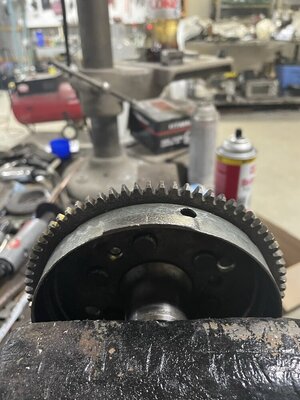- Location
- Glenmoore pa
Hey All,
I've been doing some testing on static angle changes and wanted to share my findings. The hypothetical concern after discussions with various people is that with a 56 degree static angle, there is a good bit of crank rotation between the trigger and ignition event during which time crank speed could theoretically change and cause fluctuations in actual timing. To counteract this, I wanted to change the static angle to something closer to max timing (in my case, 32). I originally intended to do this by moving the pickup location in the front cover, but with a 760 flywheel, it would end up almost hitting the bendix. So here's what i did instead...
The "lumps" on a 760 flywheel are quite big. There is a + and - signal read with these lumps. The + signal happens when the lump first passes the pickup and this is what defines the static angle. The - signal is what happens when the end of the lump passes the pickup. In +/- trigger mode, the zeel uses the + signal over 500-ish RPM. At starting/low speed, it will use the - signal to trigger timing. I calculated this at around 14 degreed. So, in +/- mode you end up with about 14 degrees timing when starting. In addition to reducing static angle, I also wanted to run lower timing during starting. So, I ground exactly 20 degrees out of each lobe and then ran + only trigger mode. I set my static angle to 36 degrees and set my startup timing in the map to around 10 degrees. I confirmed the timing is spot on with a timing light.
I've only run this setup once so far, but it seems to start a little easier and the power feels very smooth. Unfortunately, it wasn't a pure back-to-back test, but anecdotally it feels better and I can't see how it would be any worse.
I'll be doing more testing but thought this info could be valuable to someone....
P.S. - this testing was done on an XS1200 with a GP800 front cover (chopped up).
-Jordan
I've been doing some testing on static angle changes and wanted to share my findings. The hypothetical concern after discussions with various people is that with a 56 degree static angle, there is a good bit of crank rotation between the trigger and ignition event during which time crank speed could theoretically change and cause fluctuations in actual timing. To counteract this, I wanted to change the static angle to something closer to max timing (in my case, 32). I originally intended to do this by moving the pickup location in the front cover, but with a 760 flywheel, it would end up almost hitting the bendix. So here's what i did instead...
The "lumps" on a 760 flywheel are quite big. There is a + and - signal read with these lumps. The + signal happens when the lump first passes the pickup and this is what defines the static angle. The - signal is what happens when the end of the lump passes the pickup. In +/- trigger mode, the zeel uses the + signal over 500-ish RPM. At starting/low speed, it will use the - signal to trigger timing. I calculated this at around 14 degreed. So, in +/- mode you end up with about 14 degrees timing when starting. In addition to reducing static angle, I also wanted to run lower timing during starting. So, I ground exactly 20 degrees out of each lobe and then ran + only trigger mode. I set my static angle to 36 degrees and set my startup timing in the map to around 10 degrees. I confirmed the timing is spot on with a timing light.
I've only run this setup once so far, but it seems to start a little easier and the power feels very smooth. Unfortunately, it wasn't a pure back-to-back test, but anecdotally it feels better and I can't see how it would be any worse.
I'll be doing more testing but thought this info could be valuable to someone....
P.S. - this testing was done on an XS1200 with a GP800 front cover (chopped up).
-Jordan


